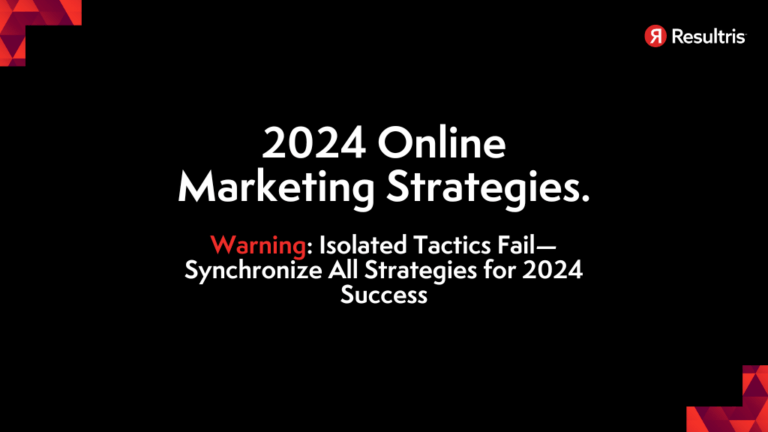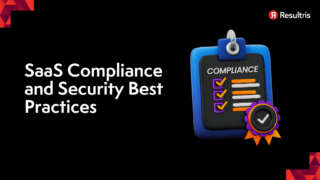

Written by: Tim Eisenhauer
Last updated:

Thank you for visiting our blog! If you’ve landed here through a Google search, you’re probably on the lookout for actionable insights into SEO and online marketing strategies that really work in today’s rapidly changing digital environment. At Resultris, we’ve refined our marketing services over the years to stay ahead of the curve, and we’re here to share our playbook with you.
First and foremost, it’s important to distinguish between marketing and sales. Marketing is a long-term commitment—it’s about building a sustainable presence and creating connections over time. Sales, on the other hand, is about seizing opportunities quickly and effectively. Both are crucial, but they require different approaches and mindsets.
In the past, we relied heavily on word-of-mouth and direct connections, but with the evolving Google algorithms and the rise of AI, the game has fundamentally changed. Websites used to thrive on content alone, but now they struggle due to new Google updates that demand more.
NOTE: Everything below needs to be done together, on a schedule, over time. Doing one without the others will just not work anymore.
You need a robust foundation: Here, we’ll explore three key areas in more depth: Technical SEO Optimization, Content Marketing, and Topical Authority. Each of these plays a critical role in your overall digital marketing strategy.
What It Is: Technical SEO refers to the process of optimizing your website’s structure and technology to help search engines crawl and index your site more effectively. This is fundamental to ensure that your content can be discovered and ranked well by search engines like Google.
How to Do It:
Ideas for Implementation:
What It Is: Content marketing involves creating and sharing valuable content to attract and convert prospects into customers, and customers into repeat buyers. The type of content you share is closely related to what you sell; you’re educating people so that they know, like, and trust you enough to do business with you.
How to Do It:
Ideas for Implementation:
What It Is: Topical authority means being recognized by both users and search engines as an authority in a specific niche or area of expertise. This is achieved through comprehensive content that covers a topic in depth.
How to Do It:
Ideas for Implementation:
Each of these strategies requires careful planning and execution but can significantly impact your online presence and success. By enhancing your technical SEO, crafting targeted content, and establishing yourself as a topical authority, you can build a solid foundation that attracts and retains customers.
Below, we delve into the specifics of Social Media Seeding, using Parasite SEO and UGC Sites, and the strategic use of Directory and Review Sites.
What It Is: Social Media Seeding involves strategically interacting on social media platforms to increase visibility and engagement. It’s about placing your content seeds across various social channels to grow your audience organically.
This means that you need to set up social media accounts on all the big ones, Facebook, Twitter/X, YouTube, TikTok, Instagram, Pinterest, and as many others as you can. The more the better. Many of these allow you to place links, fill out your company address, and provide a description of your business. You want to make sure all the info you are putting into these sites is cohesive and gives the correct signals to search engines about your company.
How to Do It:
Ideas for Implementation:
What It Is: Parasite SEO involves leveraging the authority of high-ranking third-party sites to promote your content. UGC (User Generated Content) sites like Reddit, Quora, and Medium allow users to contribute content, providing another avenue to boost your SEO and visibility. When you are sharing content, make sure it is unique from all other places. Link back to your site, link to the content you put on the other UGC sites, provide your business information, but make sure the content is valuable and not just spam.
How to Do It:
Ideas for Implementation:
What It Is: Directory and Review Sites are online listings that display business information and customer reviews. Sites like Yelp, Google My Business, Capterra, G2, SoftwareAdvice, Gartner Reviews, TrustPilot, and tons of other industry-specific directories are crucial for local SEO and credibility.
How to Do It:
Ideas for Implementation:
Each of these strategies—Social Media Seeding, leveraging Parasite SEO and UGC Sites, and maximizing Directory and Review Sites—plays a vital role in enhancing your online presence. By implementing these methods, you can ensure broader visibility, engage potential customers, and establish a strong digital footprint that supports your overall SEO efforts.
Below, we explore advanced techniques in Email Marketing and Lead Nurturing, and the indispensable role of Networking and Direct Outreach in a comprehensive digital strategy.
What It Is: Email marketing and lead nurturing are processes designed to convert prospects into customers by cultivating relationships over time. These strategies involve consistent communication with your audience, providing them with valuable content, and gradually guiding them through the sales funnel.
How to Do It:
Ideas for Implementation:
What It Is: Despite the rise of digital marketing, face-to-face interactions remain a powerful tool. Networking and direct outreach involve personal interactions, which can lead to stronger relationships and more direct business opportunities.
How to Do It:
Ideas for Implementation:
Combining these advanced techniques effectively can drastically enhance your digital marketing efforts. Email marketing and lead nurturing help maintain ongoing relationships and gently nudge prospects down the sales funnel, while networking and direct outreach can solidify these connections in more personal and impactful ways. By integrating both digital and traditional marketing tactics, you can create a more dynamic and effective marketing strategy that caters to a wider array of prospects and clients.
In the intricate world of SEO and online visibility, proving the legitimacy of your business and carving out a niche are more crucial than ever. This section covers essential strategies for affirming your company’s authenticity and effectively targeting underserved markets.
Understanding Google’s Checks: Google uses several indicators to assess whether a business is legitimate. These include the legal status of the company (corporation or LLC), the duration for which a domain is registered, and active job listings that suggest operational business activities.
How to Establish Credibility:
Some others:
By paying attention to these nuanced aspects, you can enhance your website’s credibility and authority in the eyes of both users and search engines. Implementing these strategies involves a careful balance of technical SEO, content strategy, and ongoing engagement with your audience and community, all of which contribute to a solid, long-term SEO strategy.
What It Means: Niche marketing involves focusing on a specific segment of a market that is not being adequately served. This approach can lead to less competition and a more focused audience.
How to Target a Niche:
Sales vs. Marketing: While marketing is about building a long-term brand presence, sales focus on getting immediate results. Direct interactions, such as networking and personal outreach, can often lead to quicker project acquisitions.
How to Leverage Sales:
Combining Long-term Marketing with Short-term Sales Efforts: Integrating strategic marketing with proactive sales efforts creates a balanced approach to business growth. While you develop your niche and build credibility through sustained marketing efforts, also capitalize on direct sales tactics for immediate gains. This dual approach ensures you’re not only setting up for future success but also making the most of current opportunities.
While platforms like Google Ads and social media ads can accelerate growth, they require significant investment and continuous optimization. It’s a complex arena where only sustained efforts paired with smart strategies yield returns.
Even our new venture, kokotree.com, took a year to begin seeing any significant traffic from search engines, highlighting the need for patience and persistence in SEO efforts. This journey involved in-depth content creation focused on specific topics like “preschool,” and an extensive link-building campaign.
It’s crucial to remember that Google and other search engines are continuously refining their algorithms. What worked yesterday might not work today, and staying ahead requires constant learning and adaptation. You must be ready to adjust strategies, explore new platforms, and continuously refine your approach based on performance data and changing trends.
Today’s SEO and online marketing landscape demands a more sophisticated, multi-faceted approach than ever before. At Resultris, we’re committed to adapting these strategies to ensure our clients not only keep up but stay ahead.
If you’re navigating these complex waters and need a partner who truly understands how to adapt and thrive, feel free to reach out. We’d love to discuss how we can tailor our strategies to meet your specific needs.
Thank you for considering Resultris, and we hope to collaborate with you soon. And if we don’t, we’re genuinely curious to see how others are tackling the ever-evolving challenge of online marketing!




